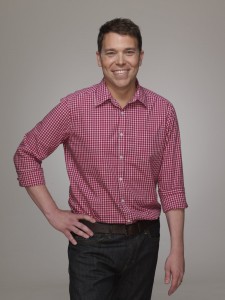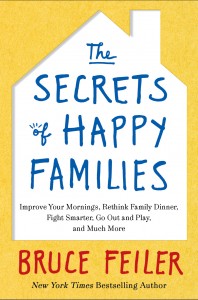JQ Magazine: JQ&A with Bruce Feiler on ‘The Secrets of Happy Families’

“One big idea in my book is that families should adapt all the time. The single best thing we’ve done is to add a weekly family meeting. We ask three questions, based on a popular program called ‘agile families.’ And no surprise: that idea was born in Japan in the culture of real-time change.” (Courtesy of HarperCollins Publishers)
By Sharona Moskowitz (Fukuoka-ken, 2000-01) for JQ magazine. Sharona is interested in fresh, new voices in fiction and creative nonfiction.
New York Times bestselling author and columnist Bruce Feiler (Tochigi-ken, 1987-88) has written a range of books dealing with topics as varied as life in Japan (depicted in 1991’s Learning to Bow), religion, and his own diagnosis with cancer.
His latest book, The Secrets of Happy Families, is a playbook for today’s family with tips and advice for increasing overall happiness and strengthening the family unit. Unlike other family-related books, Feiler does not advocate one particular method or philosophy over another; rather, he has done a thorough investigation of what happy families have in common and offers readers a slice of the pie.
In this exclusive interview, Feiler shares how his experience in Japan has given him insight into family life across cultures, as well as his take on the modern family’s trials and tribulations.
It seems the book market is already glutted with all sorts of self-help books about families. What sets your book apart and why do you feel that it is particularly timely?
In many ways, I was motivated by the deluge of self-help books. They’re boring, tried, and out of fresh ideas. As a parent, I was completely frustrated and had tons of questions about how to make my family function more effectively, and the only books out there were from “family experts.” Meanwhile, in every other arena of contemporary life—from Silicon Valley to elite peace negotiators, from championship sports teams to the Green Berets—there are proven new ways to make teams and groups run more smoothly. I wanted to know what those people were doing with their own families, then test their ideas with mine. Not every idea worked. That’s why I put over 200 new ones in the book, because what clicks with your family may be different from what clicked with mine. But my hope is that if you take three ideas, you’ll have a happier family in a week.
In the chapter about the agile manifesto, you talk about the importance of “being part of the family team.” In writing about the importance of teamwork within the family, were you inspired at all by your experience in Japan, a culture which valorizes the group above all else?
I think it may be more the other way around, in that I was attracted to Japan because I’ve always been interested in tight groups and well-run teams. At the time I lived in Japan, in the late 1980s, Americans still believed that the individual mattered above all else. But one thing we’ve learned from the Internet is that we all have a natural inclination toward groups, social networks, and other gatherings of people. The first generation of happiness research has shown us that relationships matter above all else. Happiness is other people. And the people who matter most to us are our family. Yet there have been almost no books that tell us how to do that.
Are there other cultural practices you observed in your time in Japan which you believe could benefit American families?
One I learned while in Japan is that being part of a group doesn’t just happen. Japanese schools, in particular, work on it. I remember a school trip I went on where classes were divided into small groups. The number one rule was, don’t be late. The number two rule was, only one person in each group was allowed to have a watch. Guess what! You better stick together. Having a close family doesn’t just happen, either—you have to work on it. Fortunately, there are lots of new ideas out there to do that, which I’ve tried to gather.
Throughout the book you cite examples from your own family, including marital spats with your wife and arguments between your two daughters. Did you ever have second thoughts about letting the reader in on your own personal life and the effects it might have on your children down the road?
A motto of mine is that the way to tell a big story is to tell a small story in great detail. I wasn’t interested in writing about happy families because I had one, but because I wanted one! I’m not trying to wag my finger and play the expert. I’m trying to say I’m just like you: frustrated and desperate for new ideas. This book captures our search for answers, including spats along the way.
You talk a lot about the importance of adaptability for a family. Do you think your time in Japan and the adaptability it must have required of you helped develop a sense of flexibility that has benefited your family life?
One big idea in my book is that families should adapt all the time. The single best thing we’ve done is to add a weekly family meeting. We ask three questions, based on a popular program called “agile families.” And no surprise: that idea was born in Japan in the culture of real-time change. The three questions are: 1) What went well in our family this week? 2) What didn’t go well? 3) What will we agree to work on this week. The key is to have your kids pick their own rewards and punishments. Research shows that children who plan their own time, set weekly goals, and evaluate their own work build up their frontal cortex, take greater control over their lives, and become more internally motivated.
According to the so-called “Law of Two Women,” a group is stronger for having several women among its members. I can’t help but think of your own family. Have you seen evidence of this law firsthand?
Yes! This is one my favorite ideas. It’s been proven on corporate boards, among judges, and in executive suites at Google. It also works in extended families. We used it recently when deciding whether my mother should buy a certain kind of insurance. We gathered everyone together, even those who didn’t know anything, as I had been advised, and the conversation went much better.
I interviewed countless families, and one thing I learned is we’re all frustrated to one degree or another. As Bill Ury, the author of Getting to Yes, told me, “No one knows the new rules! There’s a lot more fluidity, agility, and reinvention going on.” He was giving me some great tips about cutting down on fighting (my wife and I even changed when and where you do it!), but he said we should realize that all parents are pioneers these days.
At the end of three years of research, I found that happy families have three things in common: They adapt all the time; they talk—a lot; they go out and play. And they do one more thing: they make the decision to keep working on their family. In effect, they choose happiness. In the end, this may be the most enduring lesson of all. What’s the secret to a happy family? Try.
The Secrets of Happy Families is available Feb. 19. Bruce will discuss the book in New York City Feb. 20 at a special author event at Barnes and Noble, 150 East 86th Street, at 7:00 p.m. For more information and appearances, visit Bruce’s homepage at http://brucefeiler.com.
For JQ magazine’s 2010 interview with Bruce, click here.



Comments are closed.